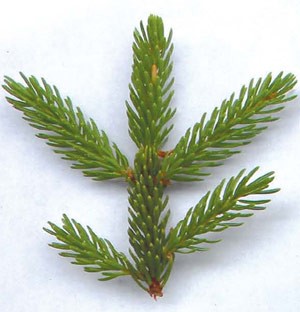The tree in question is conical, its cones dangling from skyward-curving branches, scaly bark covering its tapered trunk. Short, four-sided needles radiate spirally from each twig – unlike hemlock and fir needles, which are arranged in horizontal splays, or longer pine needles with their twig-end tufts. This tree is undoubtedly a spruce…but which kind?
While trees of the Picea genus are easy to distinguish from other conifers, specific spruce species seem to vary only subtly. Fear not. Equipped with a few identification tricks, you can impress fellow naturalists on your next outing – or at least call the devilishly spiky tree by its proper name when you direct expletives at it for assaulting you as you pass.
You may want to start by eliminating the two most visibly distinct varieties found in the Northeast – the blue and Norway spruces, both benignly nonnative and often planted as ornamentals. The unique gray-blue coloring and symmetry of Colorado blue spruce make for easy identification. Pain is certain for those who follow Frisbees and footballs into the tree’s cruelly sharp, stiff needles, the longest of any spruce in the region. Norway spruce sets itself apart in several ways; its remarkably elongated cones can reach 8 inches, and its branchlets often droop downwards rather than bending upwards, as most spruce branchlets do. (You can remember this second feature by imagining the sad foreigner missing the European region from which he emigrated.)
If you remove a needle and attempt to roll it between thumb and forefinger, Norway and blue spruce needles will resist due to their diamond shape, while white, red, and black needles, being rounder in cross section, will all roll readily. Once you’ve established that the yet-unidentified needle does not belong to a Norway or blue, you might as well pinch and smell it. If the bruised needle releases a pungent odor evocative of cat urine or skunk, it almost certainly belongs to a white spruce. You may detect subtle hints of orange rind from the red spruce and a medicinal, menthol smell from the black spruce.
If you happen to have examples of each species available for comparison, remember that the three native New England spruces have both needles and cones that increase in length by alphabetical order – from black to red to white. The lengths of black spruce’s ovoid, nearly round cones and straight, stub-like needles max out at 1.5 and .5 inches, respectively, while the narrowly oblong cones and needles of white spruce can reach up to 2.5 and .75 inches. Red spruce falls somewhere in between.
With the exception of the Norway spruce, which hardly ever flies a blue-crossed red flag, the other spruces stay true to their names. The red spruce’s twigs take on an orange-brown ochre and its bark can tend toward a reddish hue, particularly beneath the scales; black spruce’s branches and hairy twigs take on darker browns and sootier grays; skinny, waxy needles and the pale bloom of hairless twigs combine to give white spruce foliage a wispier, lighter look.
If you’re still puzzled, the species of spruce you see may depend on the ground on which you stand. The non-native Norway and blue spruces tend to stick to lawns and open grassy strips bordering highways. Red spruce, the species with the southernmost range, co-mingles with balsam fir to make up the familiar spruce-fir forest of cold mountaintops and depressions. Red spruce can extend as far south as the swamps and peatlands of the Virginia-North Carolina border, but for the most part it co-dominates the northern boreal forest alongside the white spruce. The white takes over the more favorable riparian and alluvial zones, while the black occupies the wettest, windiest, boggiest sites. Both red and white are common pioneer species of abandoned agricultural land.
The often-stressful environments of black spruce can produce stunted trees with short, scarce branches, culminating in a scruffy and narrow or club-shaped crown. Even the healthiest specimens rarely match the dense, handsome crown of white spruce. Don’t get the impression that all white spruces are handsome, though, as this species sports those large, ugly, tumor-like galls, useful in some locales for immediate identification.
Whatever the specimen before you turns out to be, hang a mental label and know the forest (or mowed and manicured landscape) that much better.



Discussion *